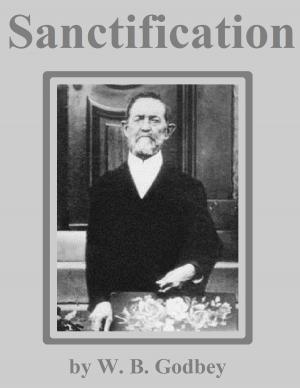The Terminology of Holiness
Nonfiction, Religion & Spirituality, Christianity, Christian Sermons, Christian Life| Author: | James Blaine Chapman | ISBN: | 1230000501569 |
| Publisher: | Jawbone Digital | Publication: | June 19, 2015 |
| Imprint: | Language: | English |
| Author: | James Blaine Chapman |
| ISBN: | 1230000501569 |
| Publisher: | Jawbone Digital |
| Publication: | June 19, 2015 |
| Imprint: | |
| Language: | English |
From the author's preface:
The material contained in this book was prepared for delivery in the Nease Lectures at Pasadena College and in the Gould Lectures at Eastern Nazarene College. The purpose of the lectures was not to convince anyone of the truth of the Wesleyan interpretation of the theme of Bible holiness but rather to offer assistance to those who hold this doctrine in the matter of describing it as accurately and fairly as possible. The plan was to say what we as a people believe in terms that we ourselves use, and by repetition and explanation help ourselves to use these terms more intelligently. Thereby we would be able to make ourselves better understood by those who do not hold with us on this central thesis of our doctrinal interpretation of the Christian faith.
Language is simply a system of symbols, and its usefulness depends upon one’s ability to interpret the symbol when others use them, and to use them so that others may interpret them readily. Thought approaches reality more closely than do words. But even thought, if it is altogether speculative and not in correspondence with reality, is far from the noblest thing in the universe.
We have, in view of these facts, not made a strong contention for words, although words are involved in the title and subtitles of our subject matter. We have sought rather to confirm the general understanding of accepted terminology which has been used by those who in the past have testified of the grace of God in Christ Jesus to the full deliverance from sin; for it is because of misunderstanding of the import of these words that much of the opposition to the Wesleyan interpretation of Bible holiness has arisen.
Nothing that we have said, however, is intended to suggest any change in the concepts of the fathers of the holiness movement of the past. They said what they believed and felt in words that were forceful and true. And there is a surprising uniformity of vocabulary among them, even though they came from many and varied historical communions of the Protestant division of the Church. It is ourselves of the present who need to be instructed rather than the fathers who require to be corrected. When it is said that “we need a new holiness vocabulary,” the meaning is that we need to have the vocabulary of the fathers revitalized in our own thinking and feeling; for the fathers found their vocabulary a splendid vehicle for the purpose they had in mind.
Words have pedigree, even as men have ancestry. But the meaning of a word involves much more than etymology. The important question is, What do these words mean to the speaker, and what do they mean to the hearers? If they mean one thing to the speaker and another thing to the hearers, they fail of their purpose of being a means for the communication of thought. Either the speaker should learn new words or else he should explain his old words-he cannot expect his hearers to do either of these things.
If any shall find occasion to disagree with some of the conclusions of this book, our prayer is that we may not allow this disagreement to becloud the main issue, which is that both reader and writer shall be established unblamable in holiness at the coming of our Lord Jesus Christ with all His saints.
The Table of Contents are as follows:
PREFACE
Chapter 1: The Importance of Terminology
Chapter 2: The Terminology of Sin
Chapter 3: The Terminology of Redemption
Chapter 4: The Terminology of Salvation
Chapter 5: The Terminology of the Christian Estate
Appendix
End Notes
From the author's preface:
The material contained in this book was prepared for delivery in the Nease Lectures at Pasadena College and in the Gould Lectures at Eastern Nazarene College. The purpose of the lectures was not to convince anyone of the truth of the Wesleyan interpretation of the theme of Bible holiness but rather to offer assistance to those who hold this doctrine in the matter of describing it as accurately and fairly as possible. The plan was to say what we as a people believe in terms that we ourselves use, and by repetition and explanation help ourselves to use these terms more intelligently. Thereby we would be able to make ourselves better understood by those who do not hold with us on this central thesis of our doctrinal interpretation of the Christian faith.
Language is simply a system of symbols, and its usefulness depends upon one’s ability to interpret the symbol when others use them, and to use them so that others may interpret them readily. Thought approaches reality more closely than do words. But even thought, if it is altogether speculative and not in correspondence with reality, is far from the noblest thing in the universe.
We have, in view of these facts, not made a strong contention for words, although words are involved in the title and subtitles of our subject matter. We have sought rather to confirm the general understanding of accepted terminology which has been used by those who in the past have testified of the grace of God in Christ Jesus to the full deliverance from sin; for it is because of misunderstanding of the import of these words that much of the opposition to the Wesleyan interpretation of Bible holiness has arisen.
Nothing that we have said, however, is intended to suggest any change in the concepts of the fathers of the holiness movement of the past. They said what they believed and felt in words that were forceful and true. And there is a surprising uniformity of vocabulary among them, even though they came from many and varied historical communions of the Protestant division of the Church. It is ourselves of the present who need to be instructed rather than the fathers who require to be corrected. When it is said that “we need a new holiness vocabulary,” the meaning is that we need to have the vocabulary of the fathers revitalized in our own thinking and feeling; for the fathers found their vocabulary a splendid vehicle for the purpose they had in mind.
Words have pedigree, even as men have ancestry. But the meaning of a word involves much more than etymology. The important question is, What do these words mean to the speaker, and what do they mean to the hearers? If they mean one thing to the speaker and another thing to the hearers, they fail of their purpose of being a means for the communication of thought. Either the speaker should learn new words or else he should explain his old words-he cannot expect his hearers to do either of these things.
If any shall find occasion to disagree with some of the conclusions of this book, our prayer is that we may not allow this disagreement to becloud the main issue, which is that both reader and writer shall be established unblamable in holiness at the coming of our Lord Jesus Christ with all His saints.
The Table of Contents are as follows:
PREFACE
Chapter 1: The Importance of Terminology
Chapter 2: The Terminology of Sin
Chapter 3: The Terminology of Redemption
Chapter 4: The Terminology of Salvation
Chapter 5: The Terminology of the Christian Estate
Appendix
End Notes















